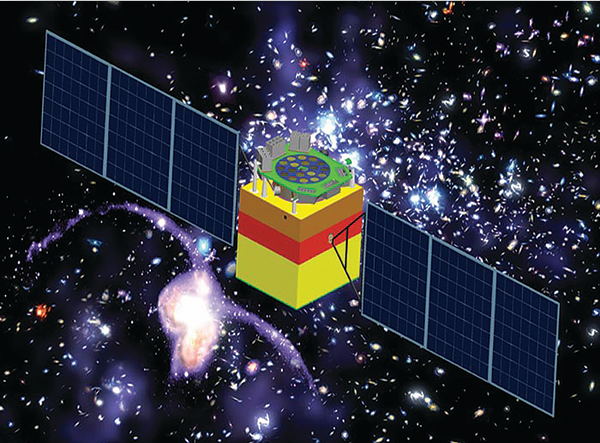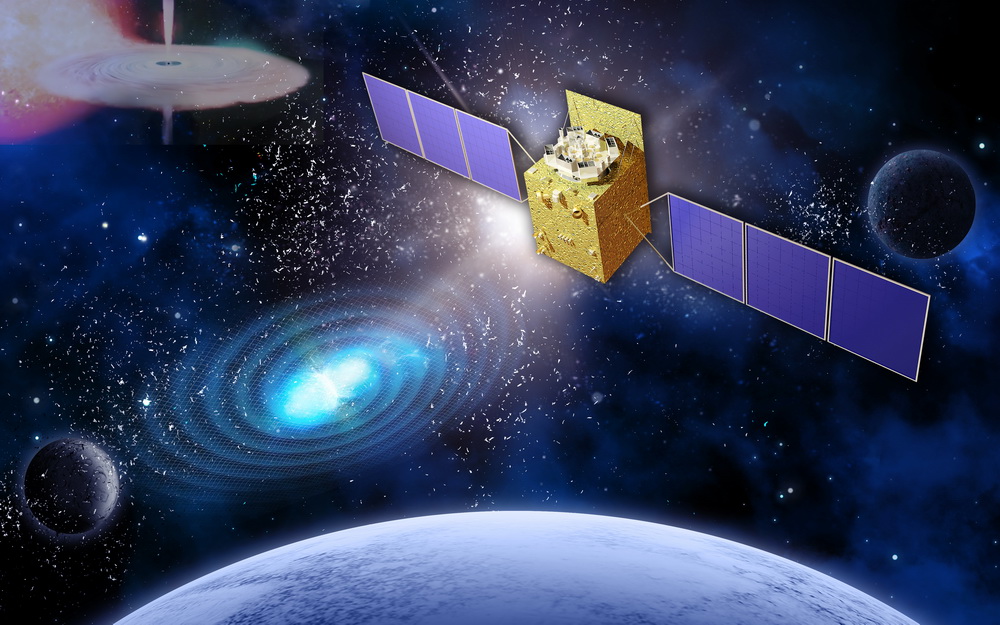Plotting a Strategy for Space
With China launching a batch of probes this year in the first part of its space priority programme, Cindy Hao discovers that funding issues may hit future missions

Grand plans The Hard X-ray Modulation Telescope’s launch later this year marks the grand finale of the first phase of China’s space-science programme. (CAS)
When the Chinese Academy of Sciences (CAS) launched its strategic priority programme in space science in 2011, the goal was to create something similar to the European Space Agency’s “Cosmic Visions” programme. With a stable budget to support space science, Cosmic Visions includes a raft of missions that will take off in the coming decades, including the Advanced Telescope for High-Energy Astrophysics X-ray observatory and the Euclid dark-universe mission.
Likewise, the CAS programme in space science promised five science satellites in its first phase, two of which have already launched. The Dark Matter Particle Explorer (DAMPE) took off in December 2015, while the Shijian-10 satellite launched in April. A decade in the making, according to Wenrui Hu, chief scientist of Shijian-10, the craft consists of an orbital module as well as a retrievable module that returned to Earth on 18 April after two weeks in orbit. It conducted 19 novel experiments under microgravity conditions – such as observing the development of early mice embryos – while experiments in fluid dynamics and combustion will continue in the satellite’s orbital module.
Although one of the missions – the KuaFu solar observatory – was indefinitely postponed in 2014, another two are scheduled for launch later this year. The Quantum Experiments at Space Scale (QUESS) satellite was due to take off in August, as Physics World went to press. It will aim to simultaneously distribute quantum encryption keys from an on-board laser source to two distant ground stations while orbiting Earth at an altitude of 1000?km. The satellite will also conduct experiments to verify Bell’s inequality and to realize quantum entanglement between earthbound and satellite-borne light sources.
The Hard X-ray Modulation Telescope (HXMT), meanwhile, will launch in November. Conceived in 1993 by Tipei Li, an astrophysicist at CAS’s Institute of High Energy Physics and Tsinghua University in Beijing, the mission will carry out a broad band – 1–250?keV – all-sky survey. The HXMT’s launch marks the grand finale of the first phase of the space-science programme.
The first phase received a total of ¥4.7bn ($700m) during the five years from 2011 to 2015, which was approved on a project-by-project basis. The CAS is now looking for missions to launch in the second phase of the programme, which received a boost in June 2015 when the academy received central government approval to rename its Center for Space Science and Applied Research (CSSAR) to the National Space Science Center (NSSC). Despite the grand name, however, the centre has not yet received its own budget to fund projects. Nor has the creation of the NSSC led to assurances for the future of space science in China.
The next batch
In 2011 and 2013 the then CSSAR selected two batches of candidates for possible second-phase projects for further investigation. As well as a space-based millimetre-range very long baseline interferometry array to capture direct images of stars and planets beyond the solar system, and a follow-up to DAMPE, the projects also included an X-ray timing and polarization (XTP) mission. The XTP is a successor to the HXMT, which would measure the timing, polarization and energy spectrum of X-rays emitted by black holes and neutron stars.
Another mission, the Einstein Probe, is an all-sky soft X-ray monitor to catch transient events such as X-ray bursts generated by implosions of neutron stars or black holes. Weimin Yuan from the CAS’s National Astronomical Observatories, who is the project’s chief scientist, says that although the second phase of the CAS strategic priority programme in space science has not officially begun, the Einstein Probe could take off around 2020 if it is approved soon.
The CAS is now looking for missions to launch in the second phase of the programme
To help promote the second-phase projects, NSSC director Ji Wu and colleagues published an article in the Bulletin of the Chinese Academy of Sciences at the end of last year, which outlined the laundry list of space probes, grouping them into programmes with poetic names and a nod to Chinese culture, including one to “feel the pulse of heavenly bodies” (Tianti haomai in Chinese). This programme aims to study time variations of electromagnetic radiation from astronomical objects and includes the XTP mission as well as cLISA – China’s version of a space-borne gravitational-wave observatory.
Reports in China have pushed an expanded version of this plan as the CAS’s strategic roadmap in space science for the next 15 years. While Wu is upbeat at drumming up public support, privately he is quite frustrated about the lack of stable funding, according to a source familiar with the situation. Wu declined an interview with Physics World, but in comments reported by the Chinese media he said he hopes that – based on the growth rate of research expenditures – the government will invest ¥8bn, ¥11.6bn and then ¥15.6bn in space science in each successive five-year period over the next 15 years.
What the NSSC really wants is a slice of the country’s total space-programme pie, which now mainly supports manned space exploration as well as practical satellites used for navigation, remote sensing and weather forecasting. But Wu may have to wait until the first batch of satellites prove themselves, with much riding on the success of DAMPE before further funds will be released.(Physics World)
?
?

